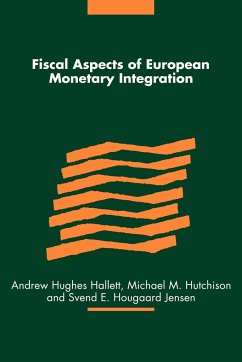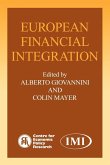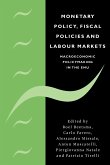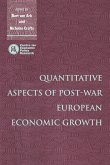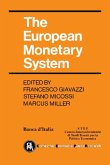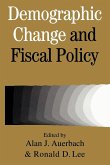Fiscal Aspects of European Monetary Integration
Herausgeber: Hughes Hallett, Andrew; Hougaard Jensen, Svend E.; Hutchison, Michael M.
Fiscal Aspects of European Monetary Integration
Herausgeber: Hughes Hallett, Andrew; Hougaard Jensen, Svend E.; Hutchison, Michael M.
- Broschiertes Buch
- Merkliste
- Auf die Merkliste
- Bewerten Bewerten
- Teilen
- Produkt teilen
- Produkterinnerung
- Produkterinnerung
A survey of fiscal policy under the restrictions of a single monetary policy and the Stability Pact.
Andere Kunden interessierten sich auch für
![Fiscal Aspects of Evolving Federations Fiscal Aspects of Evolving Federations]() Fiscal Aspects of Evolving Federations29,99 €
Fiscal Aspects of Evolving Federations29,99 €![European Financial Integration European Financial Integration]() Alberto Giovannini / Colin Mayer (eds.)European Financial Integration33,99 €
Alberto Giovannini / Colin Mayer (eds.)European Financial Integration33,99 €![Monetary Policy, Fiscal Policies and Labour Markets Monetary Policy, Fiscal Policies and Labour Markets]() R. Beetsma / C. Favero / A. Missale / V. A. Muscatelli / P. Natale / P. Tirelli (eds.)Monetary Policy, Fiscal Policies and Labour Markets33,99 €
R. Beetsma / C. Favero / A. Missale / V. A. Muscatelli / P. Natale / P. Tirelli (eds.)Monetary Policy, Fiscal Policies and Labour Markets33,99 €![Quantitative Aspects of Post-War European Economic Growth Quantitative Aspects of Post-War European Economic Growth]() Bart van Ark / Nicholas Crafts (eds.)Quantitative Aspects of Post-War European Economic Growth38,99 €
Bart van Ark / Nicholas Crafts (eds.)Quantitative Aspects of Post-War European Economic Growth38,99 €![The European Monetary System The European Monetary System]() Francesco Giavazzi / Stefano Micossi / Marcus Miller (eds.)The European Monetary System34,99 €
Francesco Giavazzi / Stefano Micossi / Marcus Miller (eds.)The European Monetary System34,99 €![European Integration European Integration]() L. Winters / Anthony Venables (eds.)European Integration29,99 €
L. Winters / Anthony Venables (eds.)European Integration29,99 €![Demographic Change and Fiscal Policy Demographic Change and Fiscal Policy]() Demographic Change and Fiscal Policy54,99 €
Demographic Change and Fiscal Policy54,99 €-
-
-
A survey of fiscal policy under the restrictions of a single monetary policy and the Stability Pact.
Hinweis: Dieser Artikel kann nur an eine deutsche Lieferadresse ausgeliefert werden.
Hinweis: Dieser Artikel kann nur an eine deutsche Lieferadresse ausgeliefert werden.
Produktdetails
- Produktdetails
- Verlag: Cambridge University Press
- Seitenzahl: 362
- Erscheinungstermin: 7. Januar 2011
- Englisch
- Abmessung: 229mm x 152mm x 21mm
- Gewicht: 587g
- ISBN-13: 9780521178273
- ISBN-10: 0521178274
- Artikelnr.: 32302457
- Herstellerkennzeichnung
- Books on Demand GmbH
- In de Tarpen 42
- 22848 Norderstedt
- info@bod.de
- 040 53433511
- Verlag: Cambridge University Press
- Seitenzahl: 362
- Erscheinungstermin: 7. Januar 2011
- Englisch
- Abmessung: 229mm x 152mm x 21mm
- Gewicht: 587g
- ISBN-13: 9780521178273
- ISBN-10: 0521178274
- Artikelnr.: 32302457
- Herstellerkennzeichnung
- Books on Demand GmbH
- In de Tarpen 42
- 22848 Norderstedt
- info@bod.de
- 040 53433511
1. Fiscal aspects of European monetary integration: an introduction Andrew
Hughes Hallett, Michael M. Hutchison and Svend E. Hougaard Jensen; Part I.
Institutions and Political Economy: 2. Institutions and fiscal policy in
EMU Niels Thygesen; 3. A political economy analysis of the Maastricht and
Stability Pact fiscal criteria Thomas F. Willett; Part II. Automatic
Stabilizers in a Monetary Union: 4. Budgetary norms and EMU Torben M.
Andersen and Robert Dogonowski; 5. Regional adjustment and the welfare
economics of monetary unification: what are the benefits of exchange rate
flexibility and fiscal insurance? Kenneth M. Kletzer; 6. Nominal stability,
real convergence, and fiscal transfers in a monetary union Svend E.
Hougaard Jensen; Discussion: Automatic Stabilizers and Fiscal Transfers
Neil Rankin; Part III. The Stability and Growth: Pact 7. The Stability
Pact: Trading-off Flexibility for Credibility? Michael Artis and Bernhard
Winkler; 8. The stability and growth pact in a model with
politically-induced deficit biases Roel M. W. J. Beetsma; 9. Implications
of the Growth and Stability Pact: why the growth element is important
Andrew Hughes Hallett and Peter McAdam; Discussion: the Stability Pact and
Fiscal Policy Clas Wihlborg; Part IV. Asymmetric Business Cycles and Fiscal
Linkages in Europe: 10. Costs of EMU and economic convergence Michael
Bergman and Michael M. Hutchison; 11. Fiscal consolidation in Europe: some
empirical issues Christopher Allsopp, Warwick McKibben and David Vines; 12.
Could the ins hurt the outs? A welfare analysis of International Financial
Fiscal Links Giancarlo Corsetti and Paolo Pesenti; Discussion: insiders and
outsiders in EMU Paul De Grauwe.
Hughes Hallett, Michael M. Hutchison and Svend E. Hougaard Jensen; Part I.
Institutions and Political Economy: 2. Institutions and fiscal policy in
EMU Niels Thygesen; 3. A political economy analysis of the Maastricht and
Stability Pact fiscal criteria Thomas F. Willett; Part II. Automatic
Stabilizers in a Monetary Union: 4. Budgetary norms and EMU Torben M.
Andersen and Robert Dogonowski; 5. Regional adjustment and the welfare
economics of monetary unification: what are the benefits of exchange rate
flexibility and fiscal insurance? Kenneth M. Kletzer; 6. Nominal stability,
real convergence, and fiscal transfers in a monetary union Svend E.
Hougaard Jensen; Discussion: Automatic Stabilizers and Fiscal Transfers
Neil Rankin; Part III. The Stability and Growth: Pact 7. The Stability
Pact: Trading-off Flexibility for Credibility? Michael Artis and Bernhard
Winkler; 8. The stability and growth pact in a model with
politically-induced deficit biases Roel M. W. J. Beetsma; 9. Implications
of the Growth and Stability Pact: why the growth element is important
Andrew Hughes Hallett and Peter McAdam; Discussion: the Stability Pact and
Fiscal Policy Clas Wihlborg; Part IV. Asymmetric Business Cycles and Fiscal
Linkages in Europe: 10. Costs of EMU and economic convergence Michael
Bergman and Michael M. Hutchison; 11. Fiscal consolidation in Europe: some
empirical issues Christopher Allsopp, Warwick McKibben and David Vines; 12.
Could the ins hurt the outs? A welfare analysis of International Financial
Fiscal Links Giancarlo Corsetti and Paolo Pesenti; Discussion: insiders and
outsiders in EMU Paul De Grauwe.
1. Fiscal aspects of European monetary integration: an introduction Andrew
Hughes Hallett, Michael M. Hutchison and Svend E. Hougaard Jensen; Part I.
Institutions and Political Economy: 2. Institutions and fiscal policy in
EMU Niels Thygesen; 3. A political economy analysis of the Maastricht and
Stability Pact fiscal criteria Thomas F. Willett; Part II. Automatic
Stabilizers in a Monetary Union: 4. Budgetary norms and EMU Torben M.
Andersen and Robert Dogonowski; 5. Regional adjustment and the welfare
economics of monetary unification: what are the benefits of exchange rate
flexibility and fiscal insurance? Kenneth M. Kletzer; 6. Nominal stability,
real convergence, and fiscal transfers in a monetary union Svend E.
Hougaard Jensen; Discussion: Automatic Stabilizers and Fiscal Transfers
Neil Rankin; Part III. The Stability and Growth: Pact 7. The Stability
Pact: Trading-off Flexibility for Credibility? Michael Artis and Bernhard
Winkler; 8. The stability and growth pact in a model with
politically-induced deficit biases Roel M. W. J. Beetsma; 9. Implications
of the Growth and Stability Pact: why the growth element is important
Andrew Hughes Hallett and Peter McAdam; Discussion: the Stability Pact and
Fiscal Policy Clas Wihlborg; Part IV. Asymmetric Business Cycles and Fiscal
Linkages in Europe: 10. Costs of EMU and economic convergence Michael
Bergman and Michael M. Hutchison; 11. Fiscal consolidation in Europe: some
empirical issues Christopher Allsopp, Warwick McKibben and David Vines; 12.
Could the ins hurt the outs? A welfare analysis of International Financial
Fiscal Links Giancarlo Corsetti and Paolo Pesenti; Discussion: insiders and
outsiders in EMU Paul De Grauwe.
Hughes Hallett, Michael M. Hutchison and Svend E. Hougaard Jensen; Part I.
Institutions and Political Economy: 2. Institutions and fiscal policy in
EMU Niels Thygesen; 3. A political economy analysis of the Maastricht and
Stability Pact fiscal criteria Thomas F. Willett; Part II. Automatic
Stabilizers in a Monetary Union: 4. Budgetary norms and EMU Torben M.
Andersen and Robert Dogonowski; 5. Regional adjustment and the welfare
economics of monetary unification: what are the benefits of exchange rate
flexibility and fiscal insurance? Kenneth M. Kletzer; 6. Nominal stability,
real convergence, and fiscal transfers in a monetary union Svend E.
Hougaard Jensen; Discussion: Automatic Stabilizers and Fiscal Transfers
Neil Rankin; Part III. The Stability and Growth: Pact 7. The Stability
Pact: Trading-off Flexibility for Credibility? Michael Artis and Bernhard
Winkler; 8. The stability and growth pact in a model with
politically-induced deficit biases Roel M. W. J. Beetsma; 9. Implications
of the Growth and Stability Pact: why the growth element is important
Andrew Hughes Hallett and Peter McAdam; Discussion: the Stability Pact and
Fiscal Policy Clas Wihlborg; Part IV. Asymmetric Business Cycles and Fiscal
Linkages in Europe: 10. Costs of EMU and economic convergence Michael
Bergman and Michael M. Hutchison; 11. Fiscal consolidation in Europe: some
empirical issues Christopher Allsopp, Warwick McKibben and David Vines; 12.
Could the ins hurt the outs? A welfare analysis of International Financial
Fiscal Links Giancarlo Corsetti and Paolo Pesenti; Discussion: insiders and
outsiders in EMU Paul De Grauwe.

